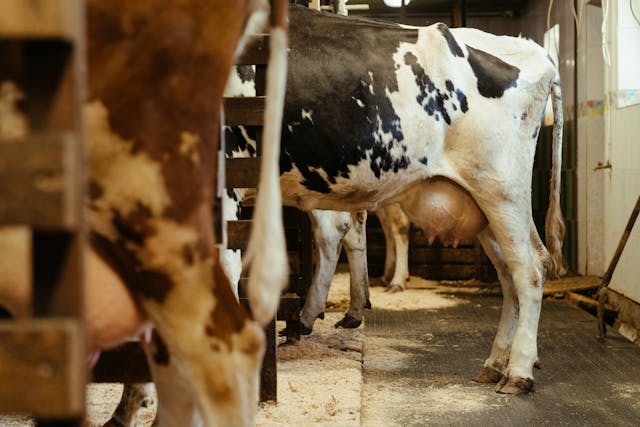Mastitis is a prevalent and costly issue in dairy farming, affecting milk production, quality, and overall cow health. While traditional methods of mastitis control focus on hygiene, milking practices, and early detection, nutrition plays a crucial yet often underappreciated role in preventing and managing this condition. By optimizing the diet of dairy cows, farmers can bolster the immune system, improve udder health, and reduce the incidence of mastitis. This article explores how targeted nutritional strategies can be a powerful tool in the fight against mastitis.
Understanding Mastitis: The Nutritional Connection
Mastitis is an inflammatory condition of the mammary gland, usually caused by bacterial infections. The severity of mastitis can range from subclinical (undetectable without testing) to clinical cases, where symptoms such as swelling, redness, and changes in milk consistency are evident. While infection is the primary cause, a cow’s nutritional status significantly influences her ability to resist and recover from mastitis.
Nutrition impacts mastitis in several ways:
- Immune System Support: Adequate nutrition strengthens the cow’s immune system, enabling it to fend off infections more effectively.
- Tissue Integrity: Nutritional deficiencies can compromise the integrity of the udder tissue, making it more susceptible to infections.
- Oxidative Stress Reduction: Certain nutrients act as antioxidants, reducing oxidative stress, which can exacerbate inflammation during mastitis.
Key Nutrients for Mastitis Control
To control mastitis through nutrition, it’s essential to focus on specific nutrients that support immune function, enhance tissue health, and reduce inflammation.
1. Vitamin E and Selenium
- Role in Mastitis Control: Vitamin E and selenium are powerful antioxidants that play a vital role in protecting udder tissue from oxidative damage. They help maintain the integrity of cell membranes and support immune function, reducing the risk and severity of mastitis.
- Recommended Levels: Dairy cows should receive 500-1000 IU of Vitamin E per day, particularly during the dry period and early lactation when they are most susceptible to mastitis. Selenium supplementation should be adjusted based on regional soil content, but generally, 0.3 ppm of selenium in the diet is recommended.
2. Zinc
- Role in Mastitis Control: Zinc is crucial for maintaining skin and tissue health, including the teat end, which is the first line of defense against pathogens. Zinc also supports the immune system, helping cows respond more effectively to infections.
- Recommended Levels: Cows should receive 40-60 ppm of zinc in their diet. Organic forms of zinc, such as zinc methionine, are more bioavailable and can be particularly effective in reducing somatic cell counts (a key indicator of mastitis).
3. Copper
- Role in Mastitis Control: Copper plays a significant role in immune function and the production of antibodies that fight infections. It also contributes to the structural integrity of tissues, including those in the udder.
- Recommended Levels: The dietary requirement for copper in dairy cows is around 10-15 ppm. However, the presence of antagonists like molybdenum and sulfur can interfere with copper absorption, so it may be necessary to adjust levels accordingly.
4. Vitamin A
- Role in Mastitis Control: Vitamin A is essential for maintaining the health of epithelial tissues, including the mammary gland. It also supports the immune system by enhancing the function of white blood cells.
- Recommended Levels: Dairy cows typically require 50,000-75,000 IU of Vitamin A per day. Supplementation is especially important during periods of increased stress, such as calving and early lactation.
5. Omega-3 Fatty Acids
- Role in Mastitis Control: Omega-3 fatty acids have anti-inflammatory properties that can help reduce the severity of mastitis. They also support overall immune function and can improve the fatty acid profile of milk, leading to healthier products for consumers.
- Recommended Sources: Flaxseed, fish oil, and algae are excellent sources of omega-3 fatty acids. Including these in the diet can help manage inflammation and support udder health.
Implementing Nutritional Strategies
To effectively use nutrition as a tool for mastitis control, farmers need to take a proactive and holistic approach:
- Balanced Diet Formulation: Work with a nutritionist to formulate a diet that meets the specific needs of your herd, taking into account factors such as lactation stage, breed, and environmental conditions.
- Targeted Supplementation: Consider targeted supplementation for cows during critical periods, such as the transition from dry to lactating. This can include boluses or top-dressing feed with essential vitamins and minerals.
- Monitor and Adjust: Regularly monitor the health and production of your herd, adjusting dietary strategies as needed. Keep an eye on somatic cell counts, which can indicate the effectiveness of your mastitis control program.
- Integrate with Other Practices: Nutrition should be integrated with other mastitis control measures, such as proper milking procedures, hygiene, and housing management, to maximize effectiveness.
The Impact of Nutritional Control on Farm Success
Investing in the nutritional management of mastitis not only improves animal welfare but also enhances farm profitability. Healthier cows produce higher-quality milk with lower somatic cell counts, leading to better milk prices and reduced culling rates. Additionally, minimizing the use of antibiotics through improved nutrition aligns with consumer demand for more natural and sustainable dairy products.
In summary, controlling mastitis through nutrition is a powerful strategy that can significantly reduce the incidence and severity of this costly disease. By focusing on key nutrients and implementing a well-balanced diet, farmers can support their cows’ immune systems, enhance udder health, and improve overall milk production. Nutrition, when combined with other mastitis control measures, offers a comprehensive approach to maintaining a healthy and productive dairy herd.


Leave a Reply